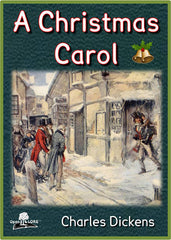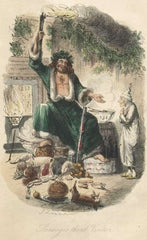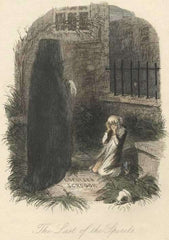A Ghostly Book of Whimsy, Warmth, and Redemption
by Bethany Wagner
 In the preface of the timeless classic A Christmas Carol, Charles Dickens greets his readers: “I have endeavoured in this Ghostly little book, to raise the Ghost of an Idea, which shall not put my readers out of humour with themselves, with each other, with the season, or with me. May it haunt their houses pleasantly, and no one wish to lay it.”
In the preface of the timeless classic A Christmas Carol, Charles Dickens greets his readers: “I have endeavoured in this Ghostly little book, to raise the Ghost of an Idea, which shall not put my readers out of humour with themselves, with each other, with the season, or with me. May it haunt their houses pleasantly, and no one wish to lay it.”
Open A Christmas Carol and step into a world filled cheerful characters, warm hearth fires, and all the joy of a classic Victorian Christmas season. But at the center of it all is miserly old Ebenezer Scrooge, who despises Christmas, and all the love and cheer that comes with it. With his characteristic “Bah! Humbug!” the miserable Scrooge scorns his family, neighbors, and employee Bob Cratchit who celebrate Christmas. He refuses to show kindness or charity to anyone. However, that Christmas Eve, Scrooge encounters three ghostly visitors who transform his outlook on Christmas and the entire world. After his encounters with these spirits, Scrooge is given a choice to return to his reclusive, greedy ways or live a more compassionate, loving life.
 Dickens penned A Christmas Carol at a time when Victorian Christmas traditions and a nostalgia for the holidays were bursting in a resurgence of sleigh rides, Christmas trees, and greeting cards. He captures all of this imagery with wit and whimsy, but also infuses the story with personal experiences and strong morals.
Dickens penned A Christmas Carol at a time when Victorian Christmas traditions and a nostalgia for the holidays were bursting in a resurgence of sleigh rides, Christmas trees, and greeting cards. He captures all of this imagery with wit and whimsy, but also infuses the story with personal experiences and strong morals.
 Poverty was a theme close to Dickens’ heart. Growing up as son to a man who spent time in debtor’s prison, he witnessed firsthand the effects of poverty in the poorest areas of London.
Poverty was a theme close to Dickens’ heart. Growing up as son to a man who spent time in debtor’s prison, he witnessed firsthand the effects of poverty in the poorest areas of London.
In 1843, Dickens wrote a pamphlet in support of poor children working in dangerous factory conditions. This pamphlet eventually took the form of A Christmas Carol. Through the creative, suspenseful narrative, Dickens invites readers to identify the Ebenezer Scrooges in themselves and inspires actions of compassion and charity.
Infused with whimsical characters and eerie adventures, the story of Ebeneezer Scrooge is one of a man walking from darkness to light, from greed to compassion, from despair to hope, from an icy winter to the warmth of spring. Dickens’ A Christmas Carol is the timeless tale of a life forever changed and the hopeful compassion annually inspired by the Christmas season.
